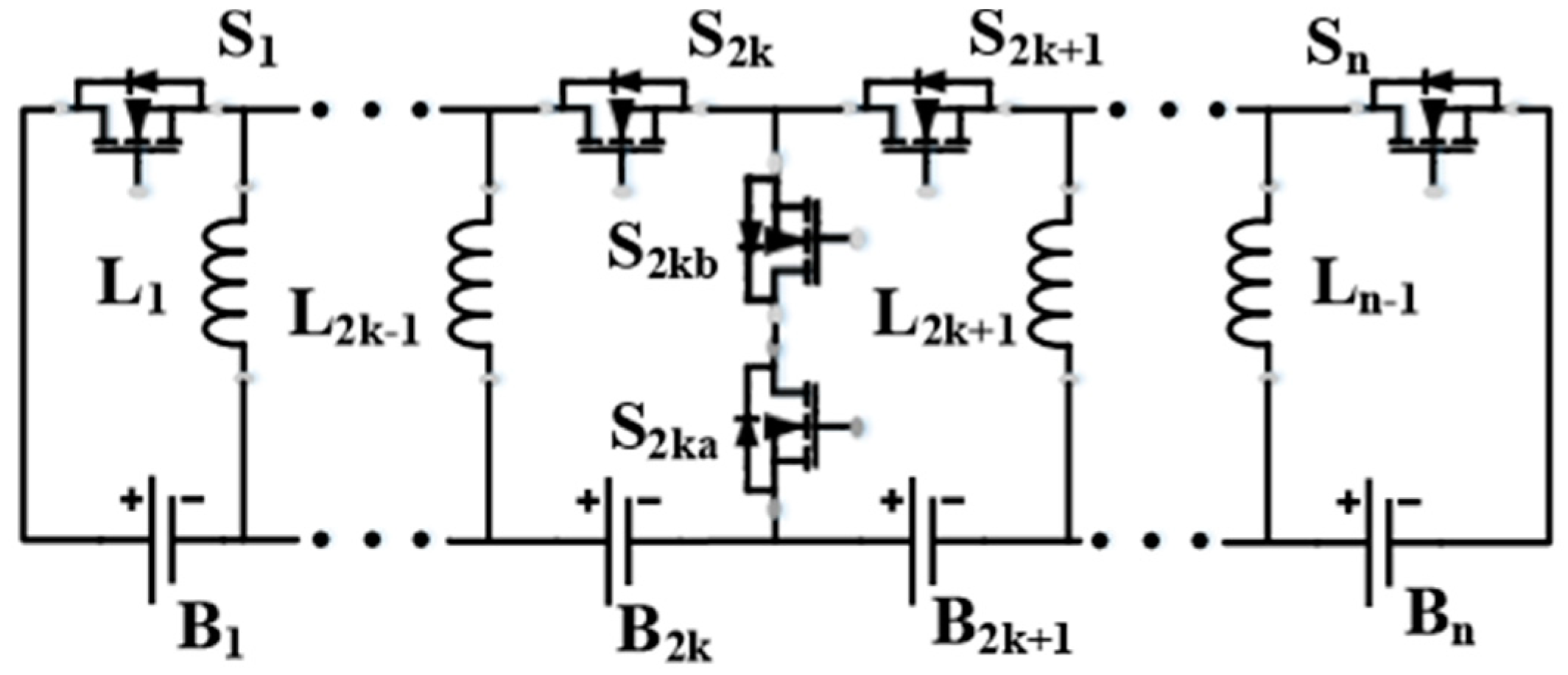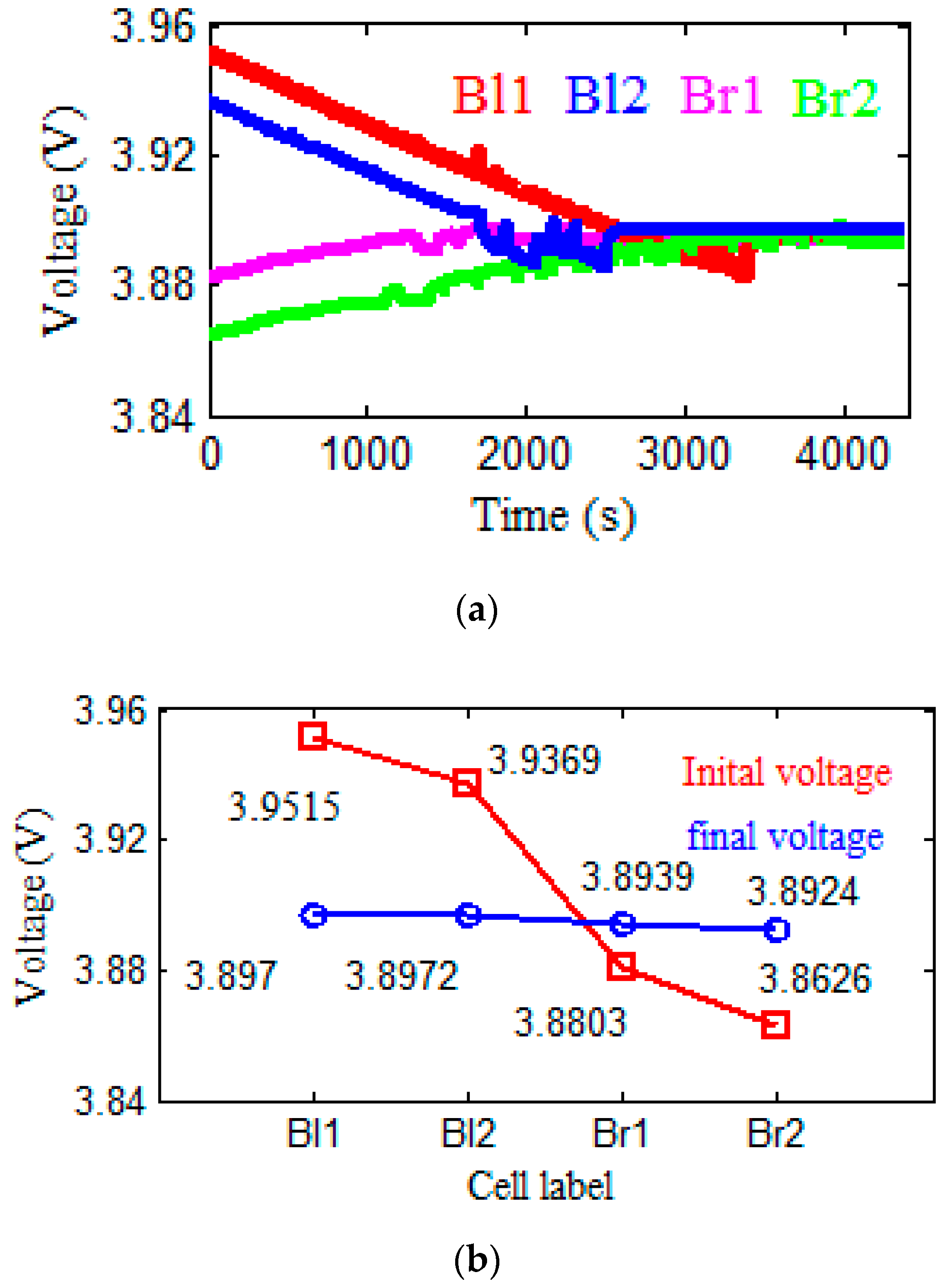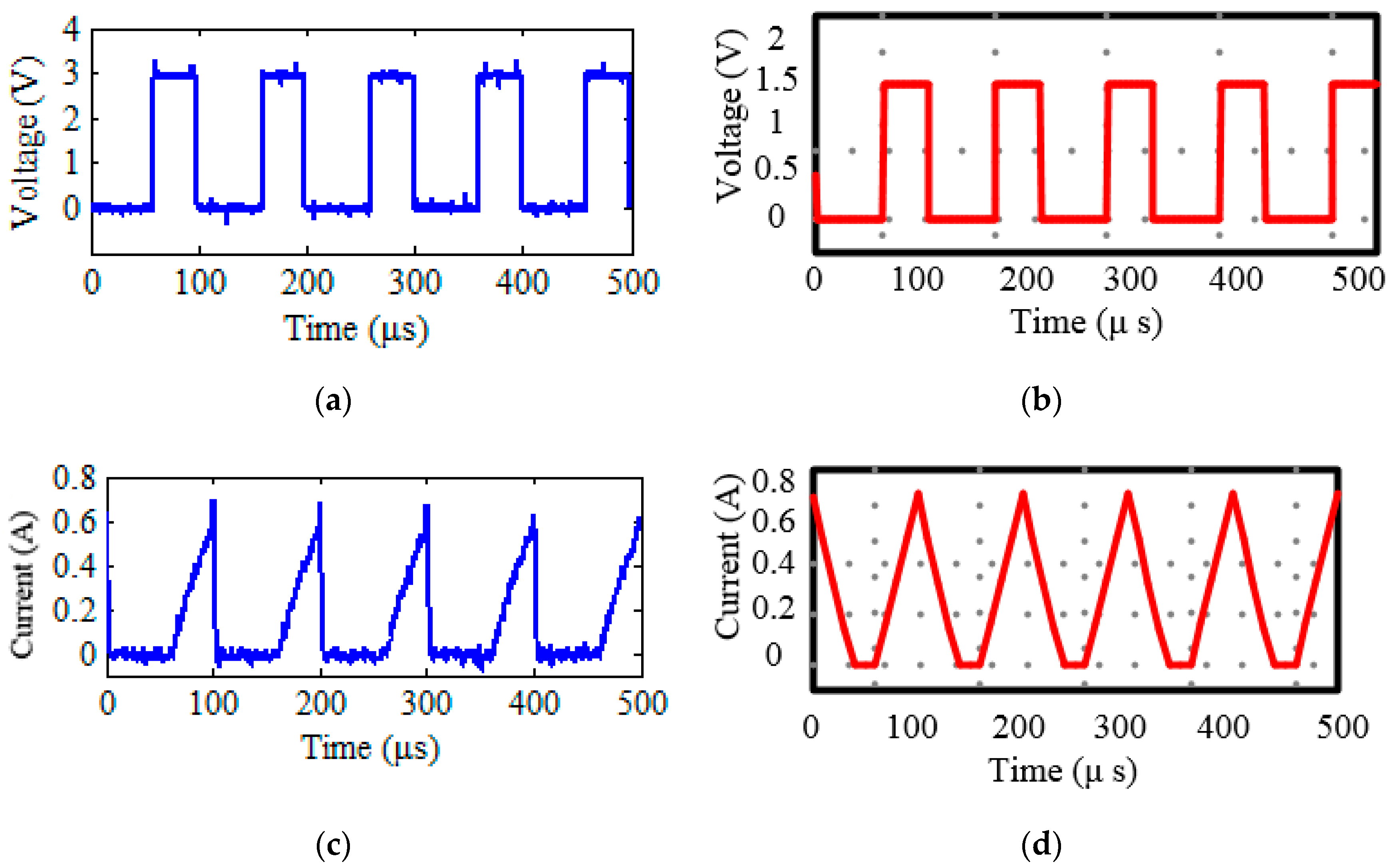1. Introduction
With the advantages of a high energy ratio, long life, high voltage and high energy density, Lithium-ion batteries are widely used in various fields [
1], such as energy storage power stations, electric vehicles (EVs), hybrid electric vehicles (HEVs), electric bicycles, electric car balance, and so on. Because of the limited voltage and capacity of a single Lithium-ion battery, multiple batteries must be connected in series or in parallel to meet the requirements of these applications [
2]. In the above applications, if the state of charge (SOC) of the batteries is less than 80%, then these batteries will not meet the requirements of the corresponding power and voltage level, and the batteries need to retire according to the relevant national regulations. Retired batteries can still be used in areas with low power and voltage requirements, such as photovoltaic energy storage power stations and battery energy storage systems (BESS) for micro-grids, to reduce cost and environmental impact. Due to the inhomogeneity among individual cells, the imbalance between them will increase after multiple charges and discharges, and the cells will need to be equalized by a battery management system (BMS) [
3].
In order to equalize the cells, a large number of battery equalization circuits have been proposed [
1,
2,
3,
4,
5,
6,
7,
8,
9,
10,
11,
12,
13,
14,
15,
16]. These circuits can be divided into two types: dissipative circuits and non-dissipative circuits [
4]. Among them, non-dissipative equalization circuits can be divided into three types according to the number of energy storage components: the first type is shown in
Figure 1; they only have one energy storage component, so they can only have two cells working at the same time, and the equalization current is small, which leads to the slow equalization speed [
5,
6]. The advantages of this circuit are small volume, simple control and low cost. As shown in
Figure 2, the number of the energy storage components are about half of the number of the batteries in the second type [
4,
7,
8,
9,
10]. This type of circuit has several cells working at the same time and the equalization current is higher than the first type, so its equalization speed is faster than the first type. But the volume, control complexity and cost are higher than the first type.
Figure 3 shows the third type, the number of energy storage components of this type is greater than or equal to the number of batteries [
1,
11,
12,
13,
14,
15,
16,
17]. This type of circuit has a large number of cells and buck-boost circuits working at the same time, and the equalization current is large, which means this type of circuit has the fastest equalization speed of the three types. Unfortunately, they also have the maximum volume, control complexity, and cost.
The volume requirements of BMS are different in different application fields. For example, the volume of BMS can be large in energy storage power stations, but the volume of BMS must be small enough in electric bicycles [
18]. Since the volume of BMS is mostly determined by the volume of the equalization circuit and the volume of the equalization circuit is mostly determined by the number of energy storage components, the three types of equalization circuit mentioned above have the same disadvantage [
19]. For example, a 48 V electric bicycle battery pack contains 12 batteries that need to be balanced. The first type of equalization circuit has only one inductor; one of the second type proposed in [
4] has 6 inductors; and one of the third type proposed in [
11] has 13 inductors. That is to say, the volume of the above three equalization circuits is fixed. However, different types of battery packs with the same voltage level have different requirements for the volume of the battery equalization circuit. If there is a need to design an equalization circuit with 2 to 5 inductors, none of the above three type can be selected [
20].
In order to solve this problem, this paper proposes a novel lithium battery equalization circuit with any number of inductors (ECANI). When the voltage level of the battery pack is determined, the ECANI can select any number of inductors less than half of the number of batteries according to the design requirements. That is to say, the ECANI can design the most suitable equalization circuit volume according to the actual situation [
21].
The structure and equalization principle of the ECANI is introduced in
Section 2. In
Section 3, simulation results show the equalization performance of the ECANI with different inductors under the same number of batteries.
Section 4 compares the experimental results with the simulation results.
Section 5 concludes the paper.
2. The Structure of The ECANI
The ECANI can be used in BMS, which contains any number of batteries. In this section, two, four and eight cells are used to explain the structure and equalization principle of the ECANI, respectively.
2.1. Two Cells Equalization Circuit
Only one inductor is used to transfer energy through four switches in the two cells equalization circuit as shown in
Figure 4. This is the base structure of the ECANI. Two cells are in series. The specific structure of the switch (metal oxide semiconductor field effect transistor; MOSFET) in the
Figure 4a is shown in the
Figure 4b.
As shown in
Figure 5, there are two steps to transfer energy from the high voltage cell to the lower voltage cell. Assumed that
has the high voltage and
has the lower voltage.
Step 1: Cell discharge
In a pulse-width modulation (PWM) cycle, turn on
and
, then cell
discharge and
increases.
where
represents the resistance of the discharge loop when
and
are turned on,
represents the inductance of
,
represents the current of
,
represents the forward voltage of the body diode of the MOSFET and
represents the turn-on time of
and
.
According to Equation (1),
can be expressed as:
reaches the top value
when
:
Step 2: Cell charge
When
,
and
are turned off meanwhile
and
are turned on, so
charges
:
So
can be expressed as:
where
represents the resistance of the charge loop when
and
are turned on, and
represents the moment when
is reduced to zero [
22].
2.2. Four Cells Equalization Circuit
As shown in
Figure 6, when the cell number is four, the ECANI can be divided into two different structures, one with one inductor and the other with two inductors. In this paper, the two structures are simply referred to as the ECANI 4-1 and the ECANI 4-2, respectively. As shown in
Figure 6a, the ECANI 4-1 is divided into two parts. The left part and the right part both contain 2 cells. Two parts of the ECANI 4-1 can be in parallel or in series and two cells in each part are in series. According to the principle in
Figure 5, any cell in the left part can exchange energy with any cell in the right part through the inductor.
The ECANI 4-2 in
Figure 6b is divided into two parts. The left part and the right part both contain 2 cells. Two parts of the ECANI 4-2 can be in parallel or in series and two cells in each part are in series. The ECANI 4-2 has four equalization modes [
23,
24].
Mode 1: One to One
As shown in
Figure 7, assumed that
has the high voltage and
has the lower voltage. The principle of equalization is the same as that shown in
Figure 5.
Mode 2: One to Multiple
As shown in
Figure 8, it is assumed that
has the high voltage while
and
have the lower voltage. In this case, the voltages of
and
are similar so they can equalize together. There are two steps to transfer energy from the high voltage cell to the lower voltage cells. Step 1: in a PWM cycle, turn on
and
, then cell
discharge and
increases. Step 2: when
,
and
are turned off meanwhile
,
and
are turned on, so
charges
and
to transfer energy from
to
and
.
Mode 3: Multiple to One
As shown in
Figure 9, assumed that
and
has the high voltage while
have the lower voltage. In this case, the voltages of
and
are similar so they can equalize together. There are two steps for
and
to transfer energy to
. Step 1: in a PWM cycle, turn on
,
and
, then cell
and
discharge and
increases. Step 2: when
,
,
and
are turned off meanwhile
and
are turned on, so
charges
to transfer energy from
and
to
.
Mode 4: Multiple to Multiple
As shown in
Figure 10, it is assumed that the two parts of the ECANI 4-2 are in series and
and
has the high voltage while
and
have the lower voltage. In this case, the voltages of
and
are similar so they can equalize together.
and
can equalize together for the same reason. There are two steps for
and
to transfer energy to
and
. Step 1: in a PWM cycle, turn on
and
, then cell
and
discharge and
increases. Step 2: when
,
and
are turned off meanwhile
and
are turned on, so
and
charges
and
to transfer energy from
and
to
and
.
When working in modes 2–4, there will be 3 or more cells participating in the equalization in the same PWM cycle, which is beneficial in improving the equalization speed. This is one of the advantages of the ECANI [
25].
2.3. Eight Cells Equalization Circuit
When there are eight cells, the ECANI can be divided into four different structures, which have one, two, three, four inductors, respectively. The four structures are simply referred to as the ECANI 8-1, the ECANI 8-2, the ECANI 8-3 and the ECANI 8-4, respectively.
As shown in
Figure 11a, the ECANI 8-1 is divided into two parts. The left part and the right part both contain four cells. Two parts of the ECANI 8-1 can be in parallel or in series and four cells in each part are in series. According to the principle of the
Figure 5, any cell in the left part can exchange energy with any cell in the right part through the inductor.
As shown in
Figure 11b, the ECANI 8-2 is divided into four parts. Each part can be in parallel or in series and contains two cells.
One type of the ECANI 8-3 is shown in
Figure 11c, which is divided into three parts. Two parts of it contain three cells and the third part contains two cells. Three parts can be in parallel or in series.
As shown in
Figure 11d, the ECANI 8-4 is divided into two parts. Each part can be in parallel or in series and contains four cells.
No matter what structure is in the ECANI, as long as it contains two inductors or more, it has four equalization modes as described in
Section 2.2. The ECANI 8-4 has two inductors more than the ECANI 8-2. So in mode 4, the ECANI 8-4 can have two or three or four inductors to participate in the equalization at the same time, which ensures that the ECANI 8-4 can use a more flexible equalization path and equalization strategy. That is to say, with the increase of the number of inductors, the volume of the equalization circuit will also increase, but more inductors means a more flexible equalization path and strategy, which will also increase the equalization current and eventually lead to the increase of the equalization speed. So in the specific application scenario, if you want to reduce the volume of the equalization circuit, choose the topology with less inductors, if you want to achieve faster equalization speed, choose the topology with more inductors. Therefore, the equalization circuit proposed in the manuscript can select as many inductors as possible when the volume of the equalization circuit allows, so as to ensure faster equalization speed.
Table 1 shows the comparison of inductors and switch numbers of different structures in the ECANI. It can be seen from the table that the number of inductors and switches increases with the increase of the number of cells. Under the same number of cells, the number of switches between different structures in the ECANI is almost the same.
4. Experimental Results and Discussion
Equalization performance of the ECANI was verified by the experiment. The experiment platform is shown in
Figure 14, which included a PC (Personal Computer), data acquisition platform, batteries, sampling circuit, drive circuit, equalization circuit, controller and oscilloscope. The experiment was carried out at room temperature. An equalization prototype with four 2.2 Ah Samsung lithium batteries was built and the parameters are summarized in
Table 6, which
represents the on-resistance of MOSFET. The frequency, the equalization threshold and the initial voltages of the cells of the experiment and the simulation were the same.
Table 3 shows the initial cell voltages in Experiment 1.
Figure 15 shows the four cells’ voltage waveforms during the equalization process. The initial voltage gap (94 mV) decreased to 5 mV at about 58 min 55 s.
Figure 16 shows a comparison of the four cells’ voltages before and after equalization. The average final voltage of the four cells was 3.9238 V in the experiment while it was 3.9368 V in the simulation. So, the average final voltage of the experiment was 0.33% lower than that in the simulation. In the experiment, batteries had internal resistance, the inductors had resistance and magnetic leakage, the MOSFETs had on-resistance, the voltage detection of the battery had errors, and so on. As a result, the average final voltage in the experiment was lower than the simulation result.
Figure 17a and
Figure 18a show the voltage waveforms of Experiment 2 and Experiment 3, respectively.
Figure 17b and
Figure 18b show the initial and final voltages for Experiment 2 and Experiment 3, respectively. In Experiment 2, the initial voltage gap (88.9 mV) decreased to 5 mV at about 64 min 16 s. In Experiment 3, the initial voltage gap (94.5 mV) decreased to 5 mV at about 66 min 40 s. It can be seen that the ECANI can equalize the battery at different initial voltage levels.
Figure 19 shows the PWM and the inductor current in mode 1 of Experiment 1 and the simulation.
Figure 19c shows the current of the inductor in the experiment. The peak value of the current was 0.696 A, which is 1.69% lower than the simulation result. Considering that the resistance of the experimental circuit and the components used in the experiment were not ideal, the current error was small enough. In summary, the accuracy of the ECANI is good.

























